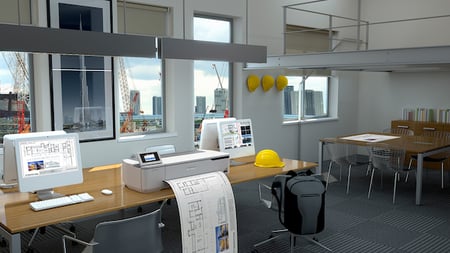While digital processes have revolutionized the way businesses operate, print continues to play a key role in day-to-day operations and workflow. As we’ve seen with wide-format printer forecasts, the market for printing and ink usage continues to have steady demand. Though we’ve discussed why printing is still necessary for businesses, there are additional factors and trends to consider when combining both print and digital processes to help maximize productivity in the long run.

Image source: Epson.
When to Choose Print or Digital
For professionals that need to access documents quickly while traveling, it can be easier to go digital. Unlike paper files that must be packed and searched manually, you can use your device on-the-go to find electronic files and information using keywords, which is especially helpful for documents that are text-heavy. In addition, some businesses work in small and space-constrained environments or multiple locations, so printing everything and storing multiple paper files or bulky equipment can be difficult.
However, many wide-format printers today come equipped with multifunction capabilities so team members can view intricate details, review, and mark up large printouts together, as well as easily scan, e-mail, and store updates to the cloud. Printers have also become much more modern and compact, allowing professionals to print at any size, when they need it, without added clutter.
While the idea of a paperless office might appeal to some businesses, the need for wide-format blueprints, plans, graphics, signage, posters, and more will continue to drive demand for printed output. For professionals working in architecture, engineering, construction, and CAD design, the ability to collaborate beyond a small tablet is valuable to team members.
Setting the Stage with Informative and Eye-Catching Materials
Making a good impression and creating a memorable experience in business meetings, presentations and events is paramount. In addition to preparation, active listening and understanding your audience, printing and signage should not be overlooked. From informative posters, agendas, and personalized promotional materials to vibrant banners and eye-catching cards and graphics, printing and signage plays a critical role in making a lasting impression, no matter the occasion.
The ability to see key information at a glance on a wide-format document is valuable, especially for large groups of team members who are reviewing projects together. When it comes to detailed or complicated materials, it’s easier to read, mark up, highlight, and write notes on high-quality and colorful wide-format documents instead of passing around a small device.
Leveraging vivid and precise maps, blueprints, signage, schedules, and more can effectively showcase intricate details and interactive elements, enhancing attendee engagement and creating a positive meeting experience.
Creating Memorable Takeaways
Having a well-documented and clear record of meeting and event takeaways is important. Discussing and writing down action items and key discussion points ensure that team decisions and objectives are met, and projects are completed on time. Meeting and event attendees also appreciate tangible takeaways that remind them of their experience — event badges, customized brochures, flyers, business cards, agendas, QR codes, and other branded merchandise can help leave a lasting impression.
People enjoy having something to hold instead of looking at everything on a screen. Carefully crafted materials with compelling visuals and relevant information not only strengthens your project, but also extends your organization’s visibility beyond the meeting or event itself.
2024 Trends to Consider
As we near the end of the year, it’s important to keep an eye on where the industry is heading and how the developments will shape the way we work. Businesses should prepare for these printing trends.
Smaller Footprint in Workspaces: There is an increasing demand for functional technology and printing solutions that can seamlessly fit into any office, production environment, or facility, even if floor space is very limited. While some of us might be accustomed to large, bulky printers, or think of small printers as lacking in features, that’s no longer the case. Businesses are leveraging wide-format printers to deliver outstanding quality graphics more quickly and efficiently than ever before — all in a small footprint.
Increased Versatility and Connectivity: Many professionals now work in hybrid work environments, moving between the office, home, or on-site in the field. As a result, there is a need for efficient remote and distributed printing and versatile solutions that enable them to connect wherever they are. For larger organizations, there is also an increased demand for remote fleet management capabilities and managed print services (MPS) that enable businesses to manage print costs, equipment utilization and service information to better manage efficiency and optimize workflow.
Minimal Need for Intervention: It’s critically important for businesses to perform routine maintenance procedures and have a thorough maintenance and cleaning plan, which will help with overall printer health and lifespan. However, on top of that, we are seeing a growing demand for robust printers that deliver high-quality output without the need for frequent manual interventions. As we discussed, advanced printing technology and software allows businesses to monitor supply levels, perform operations, and remotely diagnose service needs, maximizing productivity with minimal downtime.
Invest in Print
Working with printed wide-format graphics and documents will always offer a distinct, tangible experience beyond the limits of a small screen. While digital processes have transformed the way we access and share information, printing remains an effective tool for all environments.
Jacob Hardin
Jacob Hardin is a product manager for Professional Imaging Division at Epson America, Inc.
View All Articles



***
Viewpoint articles are tech-focused editorial written by experts from the CAD industry. This article was written by Jacob Hardin from Epson.